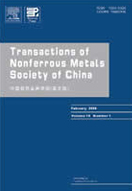Effect of heat treatment conditions on ballistic behaviour of various zones of friction stir welded magnesium alloy joints
(1. Department of Mechanical Engineering, Sri Eshwar College of Engineering, Coimbatore, 641202, Tamil Nadu, India;
2. Department of Mechanical Engineering, Sri Sivasubramaniya Nadar College of Engineering, Chennai, 603110, Tamil Nadu, India)
2. Department of Mechanical Engineering, Sri Sivasubramaniya Nadar College of Engineering, Chennai, 603110, Tamil Nadu, India)
Abstract: Ballistic behaviour of different zones of post-weld heat-treated (PWHT) magnesium alloy (AZ31B) target against 7.62 mm × 39 mm armour-piercing (AP) projectile with a striking velocity of (430±20) m/s was determined. Magnesium alloy (AZ31B) welded joints were prepared by using friction stir welding (FSW) process and subjected to different heat treatment conditions. The microhardness values of non-heat-treated and heat-treated FSW joints were investigated. The results indicated that PWHT process (250 °C, 1 h) has improved the microhardness of heat-treated FSW joints. Scanning electron microscope (SEM) microstructure showed that heat treatment has caused the formation of fine α-Mg grains and tiny precipitates and made the dissolution of β-Mg17Al12 phase into the Mg matrix. The ballistic behaviour of PWHT zones was estimated by measuring the depth of penetration (DOP) of the projectile. Lower DOP value was observed for the base metal zone (BMZ) of a heat-treated welded joint. Post ballistic SEM examinations on the cross-section of all three zones of crater region showed the formation of adiabatic shear band (ASB).
Key words: AZ31B magnesium alloy; post-weld heat treatment; ballistic behaviour; penetration depth; adiabatic shear band

